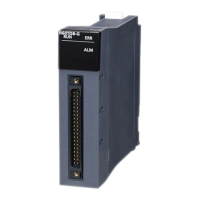378
26 REDUNDANT FUNCTION
26.2 System Switching
Manual system switching
The user can manually switch the systems between the control system and the standby system at a desired timing.
• After turning on SM1646 (System switching by a user), perform the manual system switching in the control
system.
• When the manual system switching is disabled by the DCONTSW instruction, execute the ECONTSW
instruction. The system switching is enabled in the initial status.
■System switching by the SP.CONTSW instruction
When the SP.CONTSW instruction is executed in the CPU module of the control system, the systems are switched at the
END processing after the instruction execution.
Operation of system switching by the SP.CONTSW instruction
When the SP.CONTSW instruction is executed while the tracking transfer is in asynchronous transfer mode,
such as immediately after the transition to RUN in backup mode or in separate mode, several scans may be
required for the system switching.
Once the devices and labels specified in "Tracking Setting" are transferred, the CPU modules of both the
control system and the standby system have the same specified devices and labels. Thus, if the systems are
switched by using the SP.CONTSW instruction in the CPU module of the control system, switching may also
be performed on the CPU module of new control system.
When using the SP.CONTSW instruction, create a program that does not execute the SP.CONTSW
instruction again on the CPU module of the new control system by using SM1643 (ON for only one scan after
system switching (standby system to control system)), as shown below.
M1000: System switching command, M1001: Clear signal
For details on the SP.CONTSW instruction, refer to the following.
MELSEC iQ-R Programming Manual (CPU Module Instructions, Standard Functions/Function Blocks)
END
Program executed
Execution of the SP.CONTSW instruction
System A
System B
System switching
Standby system
Program stopped
Program executed
Control system
Control system
Program stopped
Standby system

